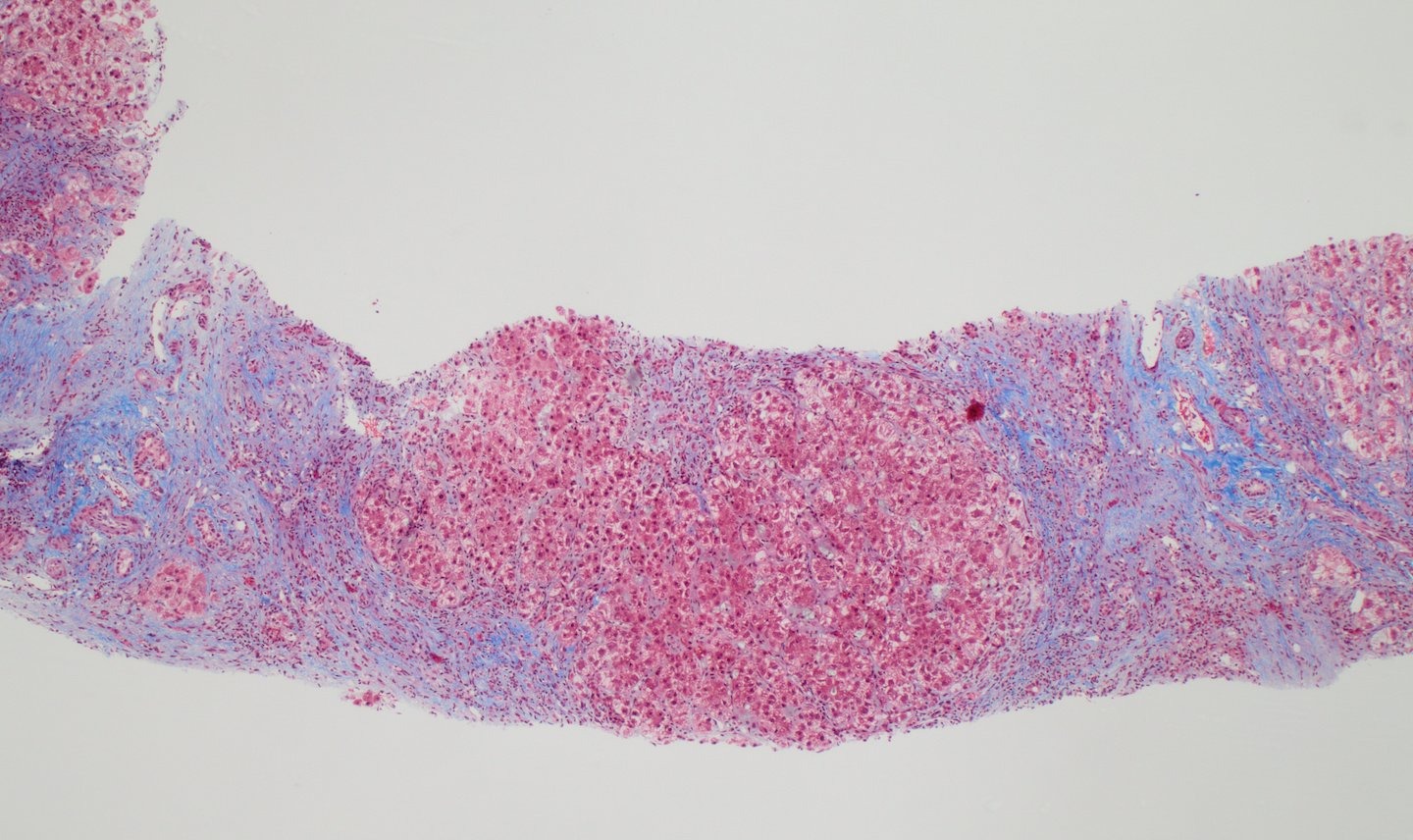Back
Poster Session E - Tuesday Afternoon
E0520 - Diagnosing Wilson Disease: Perseverance Is a Virtue
Tuesday, October 25, 2022
3:00 PM – 5:00 PM ET
Location: Crown Ballroom

Rebecca Sullivan, MD
University of Alabama Birmingham
Birmingham, AL
Presenting Author(s)
Rebecca Sullivan, MD, Chirag Patel, MD, Mohamed Shoreibah, MD
University of Alabama Birmingham, Birmingham, AL
Introduction: Wilson disease is an autosomal recessive disorder with constellation of hepatic,neurologic and psychiatric symptoms.Prevalence is varies ranging from 1:30,000 to 1:66,000 patients with 15% of patients presenting with isolated hepatic dysfunction.We present a case of a male with decompensated cirrhosis found to have Wilson disease via cumulative copper staining on liver biopsy
Case Description/Methods: 35-year-old male presented with decompensated cirrhosis.Previously diagnosed at outside hospital with etiology presumably non-alcoholic steatohepatitis(NASH) given body mass index 48,unremarkable alcohol use,viral,genetic,and autoimmune labs.On admission, AST 318, ALT 160, alkaline phosphatase 180, total bilirubin 16, and MELD-Na 25.Labs revealed ceruloplasmin level 27.4mg/dL(normal 20-60), negative slit lamp for Kayser Fletcher(KF) rings, and 24-hour urine copper 137mcg/day(normal 15-60).Given the presumed diagnosis of decompensated cirrhosis secondary to NASH, the elevated transaminases were unusual.Transjuglar liver biopsy showed marked cholestasis, hepatocyte injury, moderate portal/septal inflammation and stage 4 nodule formation.After discussion at liver disease meeting, a trial of prednisone and ursodiol was started for possible autoimmune hepatitis.Given concern for other etiologies, cumulative copper stain on liver biopsy revealed copper level 531mcg/g(normal < 50).Prior to starting copper chelating agent, patient was readmitted with MELD-Na 32 and ultimately underwent a successful liver transplant.He has followed up in clinic without complications
Discussion: Wilson disease should be considered in adults with NASH < 35 years old,AST:ALT ratio >2,significant family history,or neurologic/psychiatric symptoms.Initial work up includes serum ceruloplasmin levels, slit lamp exam,and 24-hour urine copper excretion.Liver biopsy is recommended when there is isolated 24-hour urine copper elevation.KF rings are present in 90-99% with neurologic symptoms but 50% patients with hepatic dysfunction.Leipzig scoring system uses clinical and laboratory findings with 4 points establishing diagnosis.Our patient met criteria with 24 hour urine copper >2 times and total liver copper >5 times, upper limit of normal.Cumulative copper level on liver biopsy >250mcg/g has an 83% sensitivity to diagnosis Wilson disease.Our case demonstrates the need for further evaluation in patients with newly diagnosed cirrhosis of unclear etiology as Wilson Disease can be diagnosed without KF rings and normal ceruloplasmin level

Disclosures:
Rebecca Sullivan, MD, Chirag Patel, MD, Mohamed Shoreibah, MD. E0520 - Diagnosing Wilson Disease: Perseverance Is a Virtue, ACG 2022 Annual Scientific Meeting Abstracts. Charlotte, NC: American College of Gastroenterology.
University of Alabama Birmingham, Birmingham, AL
Introduction: Wilson disease is an autosomal recessive disorder with constellation of hepatic,neurologic and psychiatric symptoms.Prevalence is varies ranging from 1:30,000 to 1:66,000 patients with 15% of patients presenting with isolated hepatic dysfunction.We present a case of a male with decompensated cirrhosis found to have Wilson disease via cumulative copper staining on liver biopsy
Case Description/Methods: 35-year-old male presented with decompensated cirrhosis.Previously diagnosed at outside hospital with etiology presumably non-alcoholic steatohepatitis(NASH) given body mass index 48,unremarkable alcohol use,viral,genetic,and autoimmune labs.On admission, AST 318, ALT 160, alkaline phosphatase 180, total bilirubin 16, and MELD-Na 25.Labs revealed ceruloplasmin level 27.4mg/dL(normal 20-60), negative slit lamp for Kayser Fletcher(KF) rings, and 24-hour urine copper 137mcg/day(normal 15-60).Given the presumed diagnosis of decompensated cirrhosis secondary to NASH, the elevated transaminases were unusual.Transjuglar liver biopsy showed marked cholestasis, hepatocyte injury, moderate portal/septal inflammation and stage 4 nodule formation.After discussion at liver disease meeting, a trial of prednisone and ursodiol was started for possible autoimmune hepatitis.Given concern for other etiologies, cumulative copper stain on liver biopsy revealed copper level 531mcg/g(normal < 50).Prior to starting copper chelating agent, patient was readmitted with MELD-Na 32 and ultimately underwent a successful liver transplant.He has followed up in clinic without complications
Discussion: Wilson disease should be considered in adults with NASH < 35 years old,AST:ALT ratio >2,significant family history,or neurologic/psychiatric symptoms.Initial work up includes serum ceruloplasmin levels, slit lamp exam,and 24-hour urine copper excretion.Liver biopsy is recommended when there is isolated 24-hour urine copper elevation.KF rings are present in 90-99% with neurologic symptoms but 50% patients with hepatic dysfunction.Leipzig scoring system uses clinical and laboratory findings with 4 points establishing diagnosis.Our patient met criteria with 24 hour urine copper >2 times and total liver copper >5 times, upper limit of normal.Cumulative copper level on liver biopsy >250mcg/g has an 83% sensitivity to diagnosis Wilson disease.Our case demonstrates the need for further evaluation in patients with newly diagnosed cirrhosis of unclear etiology as Wilson Disease can be diagnosed without KF rings and normal ceruloplasmin level

Figure: Sections show marked cholestasis with associated hepatocyte swelling. Large septal areas show bile ductular reaction with mixed septal inflammation. Trichrome stain highlights cirrhotic nodules (stage 4/4)
Disclosures:
Rebecca Sullivan indicated no relevant financial relationships.
Chirag Patel indicated no relevant financial relationships.
Mohamed Shoreibah indicated no relevant financial relationships.
Rebecca Sullivan, MD, Chirag Patel, MD, Mohamed Shoreibah, MD. E0520 - Diagnosing Wilson Disease: Perseverance Is a Virtue, ACG 2022 Annual Scientific Meeting Abstracts. Charlotte, NC: American College of Gastroenterology.
